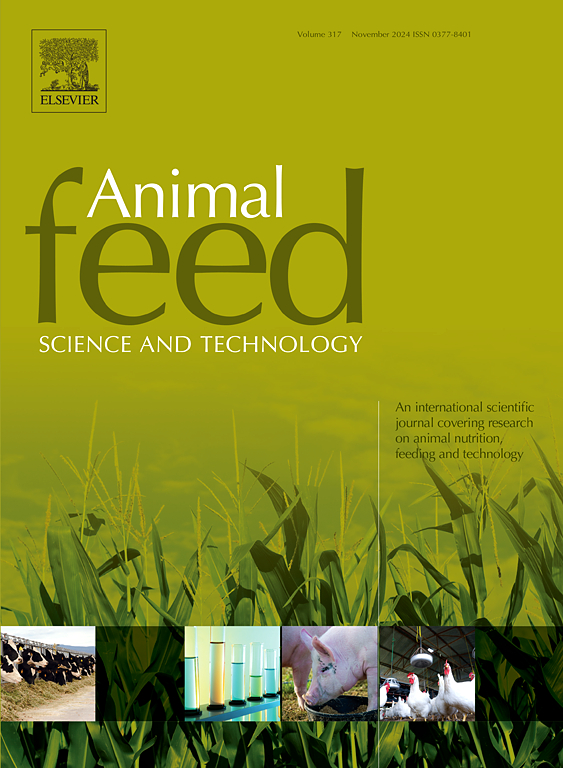青贮甜菜:取样、化学成分和混合甜菜青贮的消化率
IF 2.7
2区 农林科学
Q1 AGRICULTURE, DAIRY & ANIMAL SCIENCE
引用次数: 0
摘要
本研究的目的是:1)确定混合甜菜青贮的代表性采样方法;2)描述混合青贮的化学成分和消化率;3)评估与甜菜共青贮时菜籽粕中粗蛋白质(CP)的降解程度;4)与实验室规模青贮青贮进行比较。青贮分别于2021年11月和2022年1月进行,生产两套青贮。采用玉米青贮、草/三叶草青贮、草籽秸秆、干甜菜浆、鲜甜菜浆、油菜籽粕共青贮7种高干物质甜菜,进行圆捆大规模青贮。同时,用玉米青贮、草/三叶草青贮、草籽秸秆和新鲜甜菜果肉进行实验室规模的真空袋青贮。青贮30、92和181 d后,从包中青贮的混合青贮中获得两个样品:一个是用青贮取样钻取样的孔样品,另一个是从包侧取样的大样品。大样本在工业碗切割器中切碎,以获得具有代表性的均匀样本。为了研究与甜菜共青贮的菜籽粕中CP的降解情况,在包捆过程中向包捆中加入含有纯菜籽粕的涤纶袋。青贮181 d时,混合青贮的DM值为(平均值± SEM) 248 ± 8.10 ~ 363 ± 8.10 g/kg,青贮30 d时,所有混合青贮的pH值均低于4.2。青贮181 d时混合青贮乙醇含量在17.1 ± 12.7 ~ 140 ± 12.7 g/kg DM之间变化。混合青贮DM、pH、NH3、乙酸盐、l -乳酸盐、乙醇、乙酸乙酯、乙酸丙酯、麦芽糖和甘露醇的取样方法存在差异。对于大多数混合青贮,这些差异在青贮92天后消失,青贮稳定,可以使用青贮钻进行代表性取样。有机质消化率(OMD;青贮181 d后混合青贮的体内(从体外计算)在685 ± 3.27和903 ± 6.50 g/kg OM之间变化。化学成分因混合料的不同而不同。当菜籽粕与甜菜共贮时,没有发现CP降解的证据。此外,使用实验室规模的真空袋青贮作为大规模青贮的模型可能会导致发酵产物的高估和可发酵糖的低估。本文章由计算机程序翻译,如有差异,请以英文原文为准。
Ensiling sugar beets: Sampling, chemical composition, and digestibility of mixed sugar beet silage
The aim of this study was to 1) identify the sampling method for representative sampling of mixed beet silages, 2) describe the chemical composition and digestibility of mixed silages, 3) assess the extent of crude protein (CP) degradation in rapeseed meal when co-ensiled with beets, and 4) compare large-scale with laboratory-scale ensiled silages. Ensiling was performed in November 2021 and January 2022 to produce two silage sets. A total of 7 mixed silages were made as large-scale ensiling in round bales by co-ensiling high dry matter (DM) sugar beets with either maize silage, grass/clover silage, grass seed straw, dried beet pulp, fresh beet pulp, or rapeseed meal. At the same time, beets ensiled with maize silage, grass/clover silage, grass seed straw, and fresh beet pulp were replicated as laboratory-scale ensiling in vacuum bags. After 30, 92, and 181 days of ensiling, two samples were obtained from mixed silages ensiled in bales: 1 bore sample using a silage sampling drill and 1 large sample from the side of the bale. The large sample was minced in an industrial bowl cutter to get a representative homogeneous sample. To investigate the degradation of CP in rapeseed meal co-ensiled with beets, Dacron bags containing pure rapeseed meal were added to bales during baling. The DM of mixed silages ensiled in bales and sampled as a large sample varied between (mean ± SEM) 248 ± 8.10 and 363 ± 8.10 g/kg at 181 days of ensiling, and pH for all mixed silages was below 4.2 at 30 days of ensiling. Mixed silage content of ethanol at 181 days of ensiling varied between 17.1 ± 12.7 and 140 ± 12.7 g/kg DM for mixed silages ensiled in bales and sampled as a large sample. Differences between sampling methods were found for mixed silage DM, pH, NH3, acetate, L-lactate, ethanol, ethyl acetate, propyl acetate, maltose, and mannitol. For most mixed silages, these differences disappeared after 92 days of ensiling, where the silages were stable and could be representatively sampled using a silage drill. The organic matter digestibility (OMD; in-vivo calculated from in-vitro) of the mixed silages after 181 days of ensiling varied between 685 ± 3.27 and 903 ± 6.50 g/kg OM for mixed silages ensiled in bales and sampled as a large sample. Chemical composition varied depending on mixer feed. No evidence of CP degradation in rapeseed meal was found when co-ensiled with beets. Furthermore, using laboratory-scale ensiling in vacuum bags as a model for large-scale ensiling may result in an overestimation of fermentation products and an underestimation of fermentable sugars.
求助全文
通过发布文献求助,成功后即可免费获取论文全文。
去求助
来源期刊

Animal Feed Science and Technology
农林科学-奶制品与动物科学
CiteScore
6.00
自引率
6.20%
发文量
266
审稿时长
3 months
期刊介绍:
Animal Feed Science and Technology is a unique journal publishing scientific papers of international interest focusing on animal feeds and their feeding.
Papers describing research on feed for ruminants and non-ruminants, including poultry, horses, companion animals and aquatic animals, are welcome.
The journal covers the following areas:
Nutritive value of feeds (e.g., assessment, improvement)
Methods of conserving and processing feeds that affect their nutritional value
Agronomic and climatic factors influencing the nutritive value of feeds
Utilization of feeds and the improvement of such
Metabolic, production, reproduction and health responses, as well as potential environmental impacts, of diet inputs and feed technologies (e.g., feeds, feed additives, feed components, mycotoxins)
Mathematical models relating directly to animal-feed interactions
Analytical and experimental methods for feed evaluation
Environmental impacts of feed technologies in animal production.
 求助内容:
求助内容: 应助结果提醒方式:
应助结果提醒方式:


